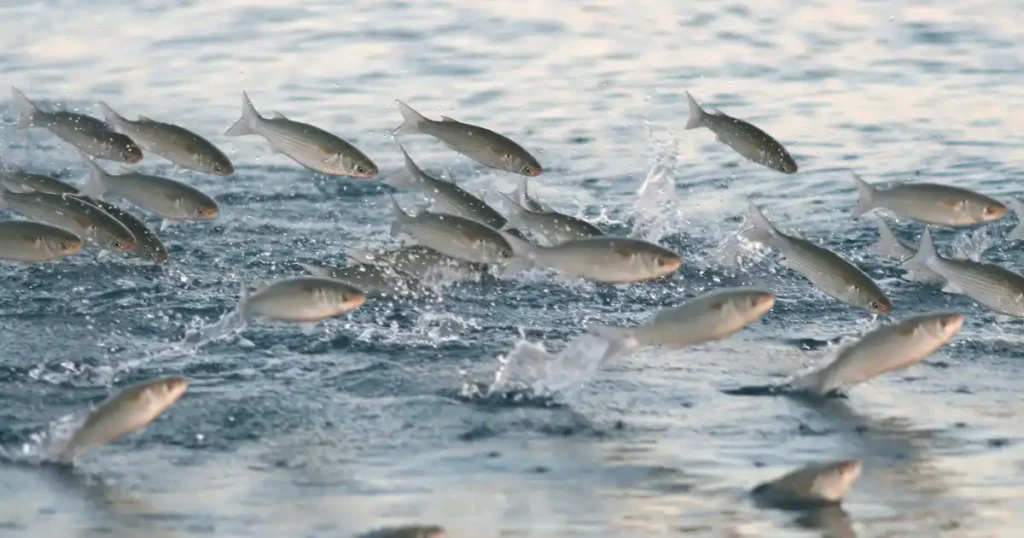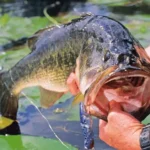Why Do Fish Jump Out of the Water? Have you ever been near a river, lake, or ocean and spotted fish dramatically launching themselves out of the water? As a longtime fishing enthusiast and aquarist, I’ve witnessed my fair share of these leaping fish firsthand. And let me tell you – it never fails to make me grin and wonder – why do fish jump?
As a curious kid fishing with my grandpa, I’d excitedly point and yell, “Did you see that?” every time a bass burst from the water’s surface chasing after a low-flying insect. Grandpa would chuckle and tell me it was the fish “going after its dinner.”
But as I grew more fascinated by these piscine acrobatics, I realized there’s more than one explanation behind this aerial behavior. Fish anatomy allows impressive jumping capacity, enabling behaviors that stem from predator evasion tactics, overcoming obstacles, evolutionary adaptions, and more.
Let’s dive below the water line to uncover what’s really going on when fish decide to defy gravity and take the plunge skyward!
Key Takeaways:
- Fish jump out of the water for several survival-related reasons, like escaping predators, catching prey, and getting past obstacles.
- Poor tank conditions can also cause aquarium fish to panic and jump.
- Certain species are naturally inclined to jump based on adaptations like anatomy and instinct.
- Preventing pet fish from leaping out involves proper tank setups, securing the tank, and choosing compatible tank mates.
- Understanding the context around jumping fish can inform fishing strategy and technique.

What’s Up With the Aerial Acrobatics?
Seeing wildlife do surprising things sparks awe and imagination. As land-walkers, we can’t help but find the spectacle of airborne fish somewhat magical.
While fish leaping through boat-formed halos and up waterfalls might look like splashy fun, there are thought-out survival reasons behind the aquatic stunts. After all, launching one’s body multiple feet into an incompatible environment isn’t usually done for laughs!
First, let’s appreciate the physicality that allows fish to rocket through their medium. Streamlined bodies, strong fins, and muscular tails equip fish for speed and maneuverability. Though not “built” for air survival, evolved abilities like labyrinth-breathing organs give some species an advantage.
This athletic design allows impressive jumping feats – sometimes even the length of multiple tank aquariums! Next, we’ll overview the common reasons that compel fish to perform these dramatic jumps.
Taking the Plunge: Common Reasons Behind the Leaping
Let’s uncover why fish decide to take the plunge from their watery realm into the precarious above-surface world. After all, the reasons behind risky behavior offer insights into natural selection and evolution.
Escape Tactics: Evading Predators and Peril
It’s hard to imagine the life-or-death battles fish face in lakes and oceans. But avoiding becoming larger fish food is a reality in the wild.
Some fish, like African butterflyfish, have sensitive natures that cause them to jump at shadows literally. But fish mainly take to the air to flee immediate hungry predators (4 times). Their instinctive reaction is to torpedo up and away to safety through a disorienting splashdown.
Schooling fish like silvery minnows use coordinated evasion tactics to confuse attackers. But if one panics, the whole group can erupt in a frenzied jump. Likewise, species frequenting the water’s upper zones are prone to accidental jump scares from passing boats or predators.
Besides, hungry hunters and poor pond ecology can also prompt panic jumping. Dramatic shifts in oxygen, toxins, or temperature create an inhospitable home that fish instinctively flee. Small puddles during drought especially inspire jumping between pockets of water.
Going Against the Current: Overcoming Obstacles
Aquatic obstacles like river waterfalls require unique solutions. Although artificial fish ladders help migrating fish like salmon access spawning grounds, nature mainly provides one log-flume-like option: jumping upstream!
A well-timed, full-body torpedo thrust allows heavy bodies to fling up several feet against gravity (2 times). Salmon and carp species time these epic leaps during annual travels to mate and reproduce. Talk about motivation to achieve some major airtime!
In fresh and saltwater tanks, decor like rocks and driftwood can also obstruct free movement. An aggravated fish may attempt an ambitious launch over these barriers – sometimes succeeding if conditions allow a clear takeoff.
An Instinct to Fly: Evolutionary Adaptations
The famous flying fish lives up to its soaring name, using wing-like pectoral fins to glide impressive distances of up to 45 meters. But before launching skyward, other adaptations like a spiked pelvic sucker and pointed tail fin give physical advantages working in tandem with instinctive behavior.
Mudskippers and other amphibious fish demonstrate specially evolved capabilities as well. Although ichthyology remains complex, modern understandings prove fish evolve impressive tools to adapt – even in terrestrial worlds initially. Continued behaviors spur the corresponding anatomy.
Clearly, survival success involves both physical gifts and mentally imprinted behaviors as fish both consciously and instinctively take to the skies.
Making a Splash: Epic Jumping Stories
What makes stunning wildlife moments even more dramatic are the improbable extremes. Let’s showcase some of Mother Nature’s most epic jumping fish as they push airborne limits.
Daring Darters: Record-Setting River Runners
Among freshwater daredevils, Asian carp take the flying trophy for both height and horizontal leaps. Driven by easily startled reflexes, individual carp have jumped over 10 ft high and 20 ft distances! Backflipping falls, and boat-crashing cannonballs bring them viral fame but troublesome invasive statuses.
Making 40-lb Asian carp look tiny, enormous Mekong giant catfish rocket up to 10 ft vertically to snatch low birds and bats from Cambodia rivers. Quick as a whip, these rare titans living 60 years emerge to feast. Safe to say, steering clear of their splash zone is wise!
High and Dry Disasters: When Aquarium Fish Take the Leap
On dry land, lucky cat owners might experience surprise bird gifts on the doorstep. But returning home to find your prized Siamese fighting fish flopping miserably out of its tank takes less cheerful turns.
Skittish aquarium jumpers like bettas, cichlids, goldfish, and guppies often leap and writhe dramatically during tank maintenance. But fatal disasters strike if no lifesaving hero intervenes promptly. Investing in secured tank lids is key for notorious escapists like eels and catfish, too.
Clearly, home aquariums face the ultimate test, housing athletic fish built to overcome obstacles. We’ll later detail prevention tactics to dodge household disasters after more wild stories unfold!
Gone Fishing: The Connection Between Jumping Fish and Angling Success
As any seasoned angler knows, animal behavior provides clues influencing fishing strategy and fortunes. The context around visible fish activity conveys information to help reel in a bountiful catch.
Bad Sign or Good? What Jumping Means for Your Catch
Encountering flashes of shimmering bodies mid-air excites keen fishermen anticipating bountiful casts. But it also prompts some head-scratching:
Does visible jumping signify prime-time fishing with frenzied feeding? Or distressed movement from poor water conditions signifying tough, bite-less outings ahead?
Typically, quality catch rates correlate with active visibility. So movement even stressed jumping, signals a higher likelihood of success thanks to the food chain energy within that habitat. But context clues require consideration, too.
Adjusting Approach Based on the High-Flying Signs
Seeing panicked minnows flee airborne or salmon struggling upstream might impact technique and location choices for positive outcomes.
Rather than fight the current flow, changing tactics based on animal activity can optimize fishing fruitfulness. Rushing river trout (2 times) may strike aggressively to conserve energy, while stagnant lake species holding positions might ignore passing baits.
As an angler, practice makes perfect reading environmental cues based on ecosystem contexts plus inhabitants’ visible behaviors. Gauging jumping’s precise meaning proves tricky but always makes casting into the action worth trying!
Preventing Your Fish from Flopping onto the Floor
If you’ve seen Finding Nemo, the scene of realization that “all drains lead to the ocean” becomes painfully ironic when a pet fish instead meets its demise on your living room floor. Finding your fish flipped behind an aquarium, standing inches from lifesaving water, is the nightmare scenario every aquarium owner wants to avoid. Luckily, some adjustments can drastically reduce this distressing risk.
Tank Setup Tips to Keep Them Inside
While fish have a natural instinct to jump, providing an environment that keeps them content and inside your tank is key. Making sure to avoid overstocking is rule number one: target ideal capacity limits and population per tank gallon to curb territorial frustration boiling over.
Proper aquarium shapes can reduce panicked wall and corner jumping collisions as open rectangles provide needed turning room. Visible plexiglass barriers also protect impulse jumpers yet allow open viewing. Lastly, keeping tank maintenance predictable and minimal helps shy species stay comfortable.
Species More Prone to Taking the Plunge
Energetic schooling fish like tetras, barbs, and danios will inevitably keep testing your tank parameters and secure lids. High anxiety lurkers like bettas and gouramis prone to angry flare-ups require vigilant monitoring, too, for meltdown prevention.
Overall, any fish positioned mid-water to breach the surface more easily merits caution. But even bottom-dwellers get spooked, so assume every scaly friend might try their flippers at flying, given the right scare.
The Science of Launching: How Fish Actually Leap From Water
Have you ever wondered about the actual mechanics behind these magnificent airborne aquatic acrobatics? What allows slender swimmers to suddenly rotate, flex, and propel multiple body lengths above water? Before eventually succumbing to gravity’s clutches?
Let’s unveil the magic behind piscatorial pole-vaulting from a fish anatomy perspective:
An Inside Look at High-Velocity Bodily Contortions
Initiating launch mode starts with a forceful C bend of the entire fish’s spine and muscles. This muscle torque generates intense energy and thrust similar to clicking into track blocks before violently unfurling forward.
Rather than resisting surrounding water, fish hydrodynamically slice fins and tails through the medium for propulsive takeoff. Angled like rudders and foils, striking fins and tails also aid steering aerial trajectories.
Once airborne, evolved anatomical parts like gliding fins or protruding pelvic suckers further aid transient torpedoes. Finally, surface tension physics assists in balancing acts before gravity ultimately prevails.
Clearly, fish have adapted strength, flexibility, and strategy, allowing amazing adaptive behaviors to meet nature’s selective challenges!
Surfing the Surface: The Life of Airborne Fish
Amazingly, some fish depend upon and even prefer surfing the boundary between aquatic and terrestrial worlds. These amphibious creatures display fascinating adaptations that allow aerial access.
Flying Fish Soar
Flying fish epitomize hybrid fish/birds gliding majestically over swelling waves before reluctantly dipping back after 30 seconds of soaring. Four wing-like pectoral fins bypass swimming to catch air currents aided by whip-like lower lobe tails.
Meanwhile, freshwater jumpers like archerfish and mangrove rivulus actively hunt above and across water boundaries. Archer’s accurate water pistol jets knock down insects in overhanging foliage. Mangroves utilize terrestrial tail-flip locomotion to chase food or escape poor water conditions for up to 66 days straight!
For these fringe species, water-to-air feats provide competitive feeding and survival advantages, cementing air-friendly lifestyles.
Jumping as a Way of Life
While marine showpeople like dolphins and whales breach more for play, other fish literally lead more balanced lifestyles thanks to their aerial abilities. Amphibious-built mudskippers, walking catfish, and snakeheads move efficiently thanks to muscular pectoral fins. Double-duty gills and protruding sacks even allow out-of-water breathing.
Between chasing insects alight trees or migrating to new waters, overland adventurers definitely take advantage of physics-defying feats their ancestors acquired. Apparently, natural selection keeps favoring the fish that can fly – even for brief, beautiful moments.
Making a Splash: Fun Fish Facts From Around the World
Before diving back underwater, let’s showcase some cultural representations celebrating these splashing sensations:
Celebrating the Quirky Cross-Cultural Symbolism
Native American folklore conveys fishing lessons through “Splash Tail,” the jumping trout outwitting an arrogant hawk. Don’t mess with Splash Tail!
Meanwhile, Danish fairy tales feature “Nokken,” a mystical shape-shifting water spirit pinpointed by fish oddly jumping out of rhythm. If you spot such jungle aquatic rhythms – swim away from that Norwegian nightmare!
FAQs: Why Do Fish Jump Out of the Water
Why do pet fish jump out of their tanks?
Pet fish can jump out of home aquariums for reasons like poor water quality, harassment from tankmates, insufficient oxygen, incorrect water temperature, overcrowding, parasite infestation, and general stress. Some fish, like bettas and gouramis, are also prone to jumping during aggressive flare-ups.
What fish are known as jumpers?
Some fish families and species known for their jumping abilities include carp, salmon, flying fish, Asian Arowana, hatchetfish, bettas, and archerfish. Mudskippers and mangrove killifish are also able to jump on land.
Do fish jump out of water in the wild?
Yes, fish commonly jump out of lakes, ponds, rivers, and oceans in the wild for reasons related to predator evasion, catching prey, getting past obstacles in their migratory paths, or responding to environmental stresses.
How can you prevent aquarium fish from jumping out?
It’s important to have proper tank setups, avoid overcrowding, use plexiglass covers or mesh tops, and select appropriate tankmates. Reducing external light and noise also helps shy fish stay calmer and content.
What does it mean if you see much jumping fish while fishing?
I encounter many visibly jumping fish while fishing, which typically signals an active ecosystem full of energy, which can translate into increased bite potential. However, the context around the jumping matters – frenzied minnows escaping predators may differ from salmon struggling to migrate upstream, for example.
How do fish use their body to jump physically?
Fish jump by first bending their spine into a C-shape and then violently straightening with thrust while slashing their fins and tails against the water. This allows them to launch up to 10 times their body length out of water before gravity brings them back down to the surface. Some species have adapted fin shapes and structures that further aid their jumping ability.
Wrap Up
Lastly, ancient Asian mythology starring powerful dragons capable of leaping from sea to sky ties symbolism about power and destiny. Water dragons control rainfall, impacting crucial harvests, so locals worked to appease mighty beasts through offerings.
Clearly, global folklore conveys shared humanity noticing – and even revering – aquatics defying gravity. These quirky embodiments remind us that nature doesn’t play by expected rules!











